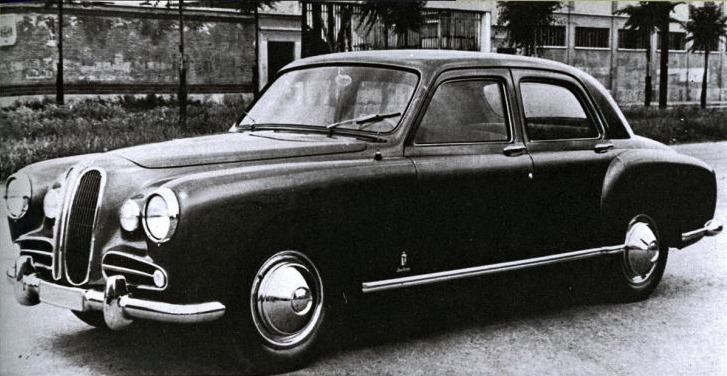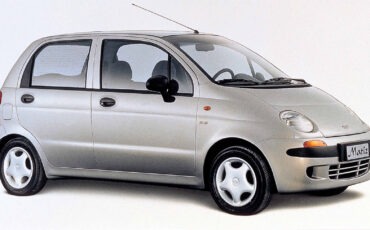
In 2013, two of the most iconic names in the automotive world, BMW and Pininfarina, came together to present a remarkable creation at the Concorso d’Eleganza Villa d’Este: the BMW Pininfarina Gran Lusso Coupé. This one-of-a-kind luxury coupé represents the first official collaboration between BMW, known for its advanced technology and signature design, and Pininfarina, the Italian powerhouse renowned for its flair for elegance and refinement. The result is a unique interpretation of a BMW coupé, viewed through the lens of Pininfarina’s design philosophy.
This collaboration marks the first time the two giants worked together formally. However, their paths crossed long before this project. In the 1950s, Pininfarina had designed a proposal for the BMW 501 sedan, which was ultimately rejected by BMW due to its resemblance to the Alfa Romeo 6C sedan. Despite the missed opportunity, the shared vision of design and engineering excellence has endured over the years, culminating in the creation of the Gran Lusso Coupé.

Ironically, today, the BMW Pininfarina Gran Lusso Coupé represents a glimpse of what could have been a lifeline for BMW’s current design struggles. In recent years, BMW’s lineup has faced harsh criticism for its bulky, uninspired aesthetics, with many critics pointing out that the brand’s new styling lacks soul, cohesion, and design logic. In stark contrast, the Gran Lusso Coupé embodies a blend of elegance, purpose, and design harmony that stands in sharp opposition to the controversial direction of BMW’s current designs.
A Harmonious Blend of Elegance and Power
At first glance, the BMW Pininfarina Gran Lusso Coupé stands out for its perfect balance of elegance and dynamism. With its broad surfaces and taut lines, the coupé exudes both strength and grace. Its classic BMW proportions — a long wheelbase, extended hood, and set-back cabin — create a powerful stance even when the car is stationary. The vehicle’s design is further enriched by Pininfarina’s holistic approach, blending BMW’s precision and dynamics with Pininfarina’s artistry.
As Adrian van Hooydonk, Senior Vice President of BMW Group Design, highlighted, the BMW Pininfarina Gran Lusso Coupé expresses BMW’s core values of luxury and imposing presence in a highly refined form, all while incorporating Pininfarina’s minimalist precision.

Looking at the current BMW lineup, with its massive front grilles, exaggerated proportions, and incoherent styling choices, it becomes clear that the Gran Lusso Coupé represents a missed opportunity. This coupé could have been the salvation for BMW’s design identity, standing as a flagship model that defined a refined, timeless aesthetic. Instead, many of the current models are seen as excessive, lacking the balanced, elegant proportions that once defined BMW’s luxury vehicles.
The Front View: Dynamic and Commanding
The front of the BMW Pininfarina Gran Lusso Coupé commands attention with its wide, wheel-focused stance, radiating dynamism and presence. At the heart of the front design is BMW’s signature kidney grille, which immediately signals the car’s heritage. Framed by round twin headlights, this grille directs the viewer’s eye toward the powerful V12 engine housed under the hood. The grille’s aluminum matte finish contrasts sharply with the glossy black structure behind it, adding depth and visual intrigue.
Above the grille, the hood stretches across the car’s width, its contours originating from the BMW emblem, creating an impression of elegant dynamism. The slim headlights reinforce the car’s focus on the road and add to its commanding presence, enhanced by the modern LED technology that offers both a premium feel and depth to the lights.

The lower part of the front fascia is dominated by a sleek sports spoiler, flanked by a single-piece air intake that accentuates the width of the front. The air intake grows larger towards the wheels, emphasizing the car’s broad track. The Pininfarina badge subtly engraved just above the road surface is a nod to the Italian design house’s contribution, like a signature on a masterpiece.
In comparison to BMW’s current models, with their enormous, often disproportionate grilles, the Gran Lusso Coupé’s front end is a lesson in restraint and harmony. Its elegance and power do not rely on excessive design elements but are achieved through thoughtful, balanced proportions that are increasingly rare in today’s BMW design language.
Sculpted Side Profile: Elegance in Motion
The side profile of the BMW Pininfarina Gran Lusso Coupé is a testament to the importance of proportion in automotive design. Here, BMW’s renowned formal language is enhanced by Pininfarina’s signature clarity and refinement. The long, flowing silhouette and convex side forms give the coupé an athletic, poised look, while the clean, precise lines elongate the vehicle, adding a sense of exclusivity.
The high beltline runs almost horizontally along the length of the car, giving it stature and presence. Above it, the roofline sweeps elegantly towards the rear, terminating in a brief extension of the car’s rear. Below the beltline, a reverse curve, starting from the air outlet behind the front wheel, moves upward towards the rear, giving the back end a light, dynamic feel. This combination of light and shadow across the surfaces creates a visually striking play of form and depth.

Attention to detail further accentuates the coupé’s elegance. A semi-matte trim behind the front wheel integrates the side indicator, while BMW’s signature Hofmeister kink in the window line is seamlessly integrated into the car’s overall design. Interestingly, the Hofmeister kink is often credited to Giovanni Michelotti, who is said to have invented the design element. Michelotti, a legendary Italian designer, later worked for BMW as a freelance designer, further embedding his influence in the brand’s design language.
Behind the Hofmeister kink, the V12 badge hints at the raw power hidden beneath the car’s refined exterior. Completing the side profile are exclusive 21-inch wheels, which amplify the vehicle’s athletic presence. With five triplet spokes, these wheels balance elegance with sportiness, their semi-matte aluminum finish adding depth and visual complexity.
This graceful side profile contrasts sharply with the chunky, bloated forms seen in BMW’s current lineup. Where the Gran Lusso Coupé is sleek and refined, many modern BMWs are seen as heavy and oversized, lacking the elegance that once made BMW coupés stand out.
The Rear View: Sleek and Sophisticated
The car’s sleek side profile transitions into an elegant rear, where horizontal elements give the back of the BMW Pininfarina Gran Lusso Coupé a wide and flat appearance. The expansive surfaces and precise contours interplay with light and shadow, lending the rear a lively, dynamic feel. One of the most striking features of the rear is the smooth transition from the roof to the rear deck, where elaborately shaped supports extend the roof pillars toward the back of the car, creating a fluid, continuous line.

The rear taillights, which extend from the side panels to the back in a single, flowing gesture, bring a sense of visual unity to the car’s design. These lights offer a fresh interpretation of BMW’s traditional L-shaped tail light design, with a slim, jewel-like quality. The lights are encased in semi-matte aluminum frames, with an open design that allows air to pass through, a testament to the attention paid to every design detail.
A Modern Interpretation of Classic Values: The Interior
Inside the BMW Pininfarina Gran Lusso Coupé, the same modern elegance and dynamic authority seen on the exterior continue. The cabin offers an exclusive atmosphere where sportiness, luxury, and comfort combine for a unique driving experience. The interior’s flowing geometry is given new character through Pininfarina’s distinct touch. A carefully selected color scheme, high-quality materials, and geometric detailing in the doors, center console, and instrument cluster elevate the experience. Pininfarina’s attention to both elegance and innovation shines through in every detail.
The luxurious four-seat layout welcomes both the driver and passengers into a space that balances comfort with sportiness. The front and rear seats, designed by Pininfarina, provide a snug embrace with side supports that offer maximum comfort. The driver’s seat features BMW’s signature driver-oriented layout, with all driving functions angled slightly toward the driver for optimal ergonomics.
Materials throughout the cabin are of the highest quality. The interior is wrapped in premium leather in shades of black and tobacco brown, sourced from the prestigious Foglizzo leather workshop. Accents of black chrome offer a sleek contrast to the natural materials used.

48,000 years old Wood
Perhaps the most remarkable aspect of the BMW Pininfarina Gran Lusso Coupé’s interior is the use of kauri wood, a material that’s over 48,000 years old. Sourced exclusively for this car by Italian craftsmen from Riva 1920 (already responsable for the stunning Cambiano concept car interior), the kauri wood’s unique grain changes from gold to red to brown, depending on the angle of the light. This ancient, fossilized wood, polished and oiled to perfection, adds warmth and natural beauty to the interior.
Italian fine wool fabric lines the roof, with a Prince of Wales check pattern adding a touch of sophistication. Even the smallest details, like the seat stitching, echo this pattern, creating harmony throughout the cabin. To ensure a bright and inviting atmosphere, the interior features an elongated roof opening, illuminated by soft white LED lights. Luxurious carpeting in a deep gray hue completes the sense of well-being within the car.
A Timeless Masterpiece
The BMW Pininfarina Gran Lusso Coupé is a true testament to the power of collaboration between two legendary automotive brands. By combining BMW’s engineering precision with Pininfarina’s design elegance, the Gran Lusso Coupé offers a vision of what luxury cars should embody—refinement, purpose, and timeless beauty. In contrast to BMW’s current design struggles, this coupé stands as a reminder of the brand’s potential to create vehicles that balance boldness with grace. With its exquisite craftsmanship, attention to detail, and a nod to BMW’s design heritage, the Gran Lusso Coupé remains a symbol of what could have been a defining chapter in BMW’s future.















